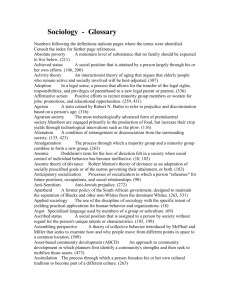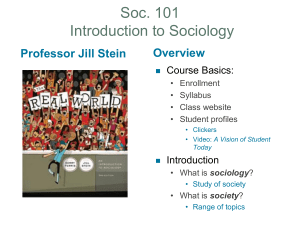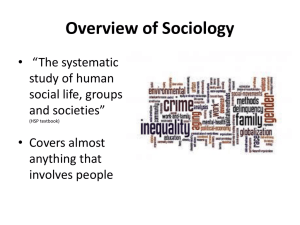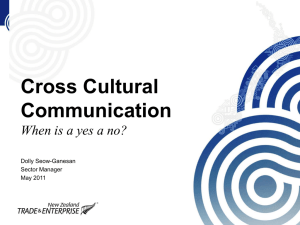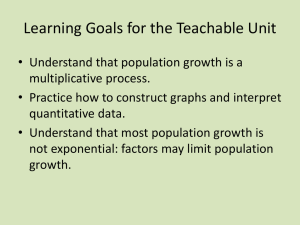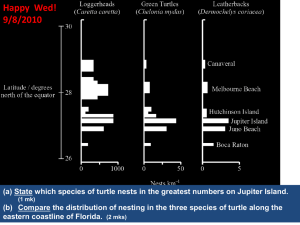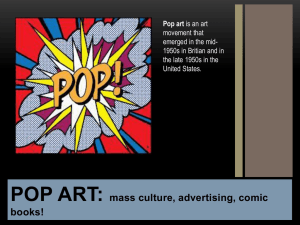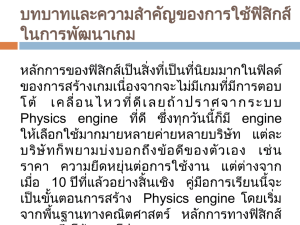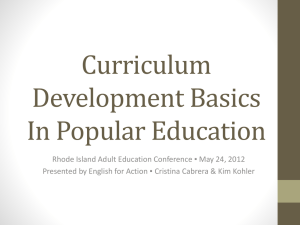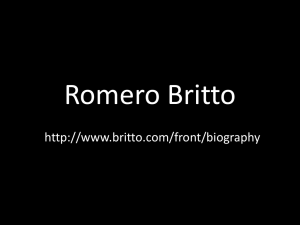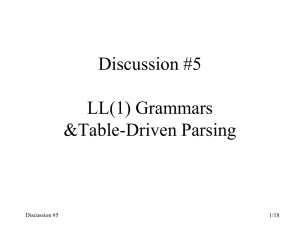The Social Organization of Popular Culture
advertisement
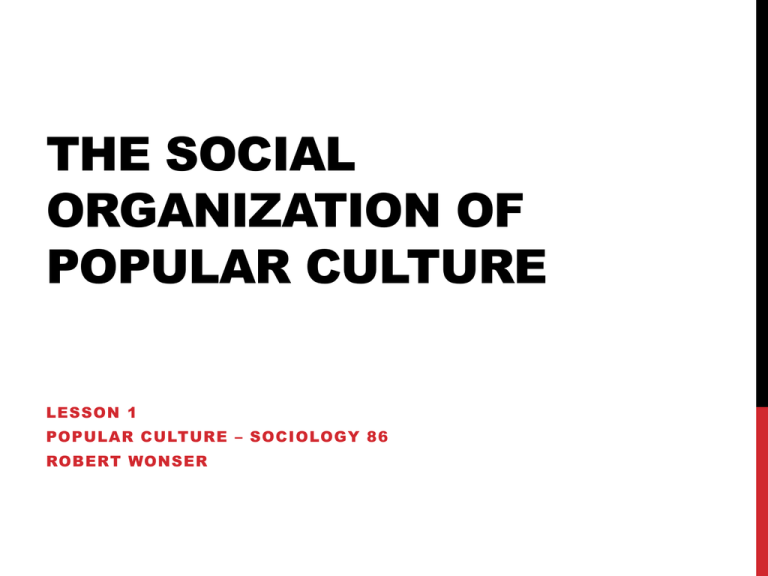
THE SOCIAL ORGANIZATION OF POPULAR CULTURE LESSON 1 POPULAR CULTURE – SOCIOLOGY 86 ROBERT WONSER SOCIAL ORGANIZATION OF POP CULTURE LESSON OVERVIEW The Sociological Imagination Some notes about pop culture What is popular culture? • Popular? • Culture? Why culture is important Pop culture as a collective activity Interpretive communities Producing and consuming popular culture Three Approaches to the Sociology of Media and Popular Culture POPULAR CULTURE DIFFERS FROM CULTURE • Culture refers to a particular way of life, whether of a people, period, a group, or humanity in general. • Culture ≠ popular culture (necessarily) • Popular culture refers to the aesthetic products created and sold by profitseeking firms operating in the global entertainment market. WHAT IS POPULAR CULTURE? Culture arises organically from what people do. Popular culture does this too, but with products produced by profit seeking firms. Results in peculiar characteristics: • Formulaic • Appeals to ‘mass audiences’ • ‘lowest common denominator’ • Profit-driven CULTURE All Culture then is richly symbolic, invested with meaning and significance. The meanings attributed to culture are never simply given but are the product of human invention, socially constructed and agreed upon among a demonstrably large number of society’s members. Finally, for culture to be sensibly understood it must be embodied in some kind of recognizable form. SOCIALLY CONSTRUCTED All reality, including popular culture, is socially constructed. Individuals interact with one another in patterned ways. From these interactions meaning emerges. This is the process of social construction. The meanings become solidified in our institutions. SOCIAL INSTITUTIONS Social institutions are patterned and predictable ways of interacting (statuses and roles) that are the product of human invention but once created, exist outside of any individual. ‘The media’, as in the institutions which create, coopt and produce popular cultural content (like movies, tv and music) are examples of an institution. ART WORLDS Art World is composed of all the people involved in the production, commission, preservation, promotion, criticism, and sale of art. Howard S. Becker describes it as "the network of people whose cooperative activity, organized via their joint knowledge of conventional means of doing things, produce(s) the kind of art works that art world is noted for" (Becker, 1982). Sarah Thornton describes it as "a loose network of overlapping subcultures held together by a belief in art. They span the globe but cluster in art capitals like New York, London, Los Angeles, and Berlin." POPULAR CULTURE AS COLLECTIVE ACTIVITY Artworlds are networks of participants whose combined efforts create movies, novels, musical compositions, comic books, advertising and so forth. ‘scenes’ • ‘When an artist creates they create with the conventions and modalities of a scene in mind • This is learned, sounds like a ‘generalized other’ in Mead’s terms • ex: jazz as improvisational Division of labor • Ex: closing credits on a movie IT TAKES A COLLECTIVE Pop culture is never the product of a solitary artist but always emerges from a collective activity generated by interlocking networks of cultural creators. Popular culture is produced, consumed, and experienced within a context of overlapping sets of social relationships. POP CULTURE IS MICRO AND MACRO Popular Culture is not just a macro level phenomenon. It is also comprised of micro level interactions. For example: you and your friends INTERPRETATION Audiences draw on their own social circumstances when attributing meaning and value to popular culture. These meanings are patterned according to persistent systems of social organization structured by differences in socioeconomic status, nationality, race, ethnicity, gender, sexuality, religion, or age. These are called interpretive communities Though, often a dominant ideology reigns SO, WHICH OPINION IS CORRECT? Bieber is Awesome! Nah, Bieber sucks! Meaning, interpretation and value are not ultimately decided by the creators of media and popular culture (though they do have some input), but by its consumers. Cultural objects are multivocal because they say different things to different people. MEDIA, WITH OTHER PEOPLE Most media is consumed in the presence of others as collective activities Could you imagine a concert, movie, etc with no one else present? • Ex: book clubs, televised events, MMORPGs, viewing parties. PRODUCING AND CONSUMING POPULAR CULTURE Who does what? Distinctions between cultural consumption and production are blurring (ex: youtube mashups) The tools of pop culture making are being democratized The creator’s control of how enterprising consumers actually make use of cultural objects in the real world is diminishing 1966: Adam West’s portrayal of Batman was intended to be serious, not campy. THREE APPROACHES TO THE SOCIOLOGY OF MEDIA AND POPULAR CULTURE Functionalist approach illustrates how culture “functions” as the social glue that generates solidarity and cohesion within human groups and societies Contemporary collective rituals—hs football games, local parades and pep rallies, award ceremonies—forge emotional bonds of recognition, identity, trust, commonality within communities and other social groups Pop culture provides the source material for consumers to communicate with strangers • Band T-shirts THREE APPROACHES TO THE SOCIOLOGY OF MEDIA AND POPULAR CULTURE Critical approach maintains that the ascendance of certain kinds of popular culture can be explained primarily in terms of their ability to reflect and reinforce the enormous economic and cultural power of the mass media industry (and broadly capitalism itself). A top-down form of domination that we actively seek out and enjoy in our subjugation Have you ever wondered why movies or music seem derivative and predictable? THREE APPROACHES TO THE SOCIOLOGY OF MEDIA AND POPULAR CULTURE Interaction approach emphasizes the power that informal processes like word-of-mouth and peer influence enjoy in the cultural marketplace Consumer tastes are deeply affected by those around us Why were initial Friday ticket sales high but low later Friday and Saturday? THE SOCIOLOGICAL APPROACH The sociological imagination is a quality of the mind that allows its possessor to think in critical manner about the world with a particular emphasis on the intersection of history and biography. Would you be you if your society’s history was different? Would you be you your biography was different? • E.g. had you grown up elsewhere, different time or place, hung around a different crowd Think about whatever interests you (probably what motivated you taking this course). How has it made you, ‘you’? NOSTALGIA Are you a ‘90’s kid?’ Take Buzzfeed’s quiz and find out! Why do we long for the past? What role does it play in consumption today? CONCLUSION AND REFLECTION Understanding pop culture is a way of understanding society. • For example, in what ways do your musical choices highlight your social position in terms of things like class, age, race, gender, identity, etc.?






